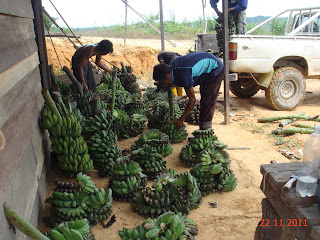 |
| The largest tree at the left. |
We added 20 trees of Berangan Banana at the fringe, near to the site of the abandon shed. There are some fruits trees here. A rambutan, jambu air and a couple of lime trees. We hope to generate more Berangan (higher value) sucklings to replace the current bananas. We also too the opportunity to made some cuttings of the lime tree to bring back to our nursery. Hopefully we can transplant it back to parcel 1 in a couple of months.
There is a rubber tree, suddenly drying off. The upper trees are gone. The tree turns harden, dries off, and decay as dry wood. Do not really know what is happening to it. We cut off the top till the stem had not harden and that still produce latex. Shall monitor this next month. Hope this is effective. This is different from the Dry Bark Disease on Parcel 2. Hope to find out what is wrong and what is the appropriate action to take soon.

Explored the fringe of Parcel 1, there is about less than an acre of land here. Making plans to clear and plan. Clearing may be a bit difficult as it's the rainy season. May have till wait till next year to start work. We have lots of options here, we may go for rubber trees or even fruit trees. As the land here is not terraced and has a good top soil, the potential is enormous. Entering this to the do list 2012 project.
We are almost at the end of the year. The Banana trees planted earlier has bear fruits and we are harvesting. Special thanks to our pioneer co-coordinator. We are thankful that he had shown us the direction. However, we wished we should had planted the whole parcel with Banana. Anyway we are expanding on the Banana and moving up market. Our new planting are of higher grades of Banana, Berangan type. Hopefully we shall have a higher value and grade of harvest soon.
 Our first harvest was a failure cause we do not have the experience to check for maturity of the banana, over anxious and harvested too early. We could not sell off our produce, mainly due to buyers rejecting our banana because of maturity. It was a good lesson. We manage to enlist the help of a friend to help us sell off, by using carbide to ripen the banana. We manage to recover only about 30% of the first harvest. Our friend also help to train us to harvest the banana and help us sell off the produce as he has a small stall. As the produce is just starting, and not much, we supply him all our bananas for the moment.
Our first harvest was a failure cause we do not have the experience to check for maturity of the banana, over anxious and harvested too early. We could not sell off our produce, mainly due to buyers rejecting our banana because of maturity. It was a good lesson. We manage to enlist the help of a friend to help us sell off, by using carbide to ripen the banana. We manage to recover only about 30% of the first harvest. Our friend also help to train us to harvest the banana and help us sell off the produce as he has a small stall. As the produce is just starting, and not much, we supply him all our bananas for the moment.Once our harvest grows, we shall have to look for a market. We are modifying our processing of banana at site so as to save space & weight on transport. The waste can also be left to compose at the farm, to be reuse as fertilizer. We are learning to process as this is the first time of what we hope to be a regular affair.























